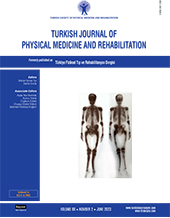Scapular dyskinesis and loss of cervical lordosis in myofascial pain syndrome and its effects on pain and posture disorders
2 Department of Physical Medicine and Rehabilitation, Erzurum Regional Training and Research Hospital, Erzurum, Türkiye DOI : 10.5606/tftrd.2023.10652 Objectives: This study aimed to evaluate scapular dyskinesia and loss of cervical lordosis in myofascial pain syndrome and its effects on pain and posture disorders.
Patients and methods: In this cross-sectional study, 101 individuals (74 females, 27 males; mean age: 44.3±8.8 years; range, 25 to 60 years) with chronic neck pain were recruited between January 2021 and February 2021. Demographic and clinical data of the patients were recorded. Visual Analog Scale (VAS), posture evaluation form, the scapular dyskinesia test, the lateral scapular shift test, and Cobb`s methods for cervical angle measurements were used in the evaluation of the patients.
Results: In the study population, 52.25% of patients had loss of cervical lordosis, and 44.5% of patients had scapular dyskinesia. It was observed that the VAS activity score was significantly higher in individuals with loss of cervical lordosis, all VAS scores and pain duration were significantly higher in individuals with scapular dyskinesia (p<0.05). Shoulder elevation, rounded shoulder, forward head posture, and kyphosis were significantly higher in patients with scapular dyskinesia, while thoracic kyphosis was significantly higher in patients with both scapular dyskinesia and loss of cervical lordosis (p<0.05). The presence of trigger points was found to be significantly higher in patients with scapular dyskinesia and in patients with both scapular dyskinesia and loss of cervical lordosis (p<0.05).
Conclusion: In patients with chronic neck pain diagnosed with myofascial pain syndrome, the presence of loss of cervical lordosis and scapular dyskinesia have negative effects on pain and posture.
Keywords : Cervical lordosis, myofascial pain syndrome, neck pain, posture, scapular dyskinesia

















